Thermo Fisher Scientific TaqMan GMO Screening Kit Mode d'emploi
- Taper
- Mode d'emploi

For testing of Food and Environmental samples only.
TaqMan™ GMO Screening Kit
USER GUIDE
Real-time PCR detection of GMO DNA in food and feed samples
for use with:
Applied Biosystems™ QuantStudio™ 5 Real‑Time PCR Instrument
Applied Biosystems™ 7500 Fast Real‑Time PCR Instrument
Catalog Number4466334
Publication Number MAN0013475
Revision D.0

Oxoid Limited | Wade Road | Basingstoke, Hampshire UK RG24 8PW
For descriptions of symbols on product labels or product documents, go to thermofisher.com/symbols-definition.
The information in this guide is subject to change without notice.
DISCLAIMER: TO THE EXTENT ALLOWED BY LAW, THERMO FISHER SCIENTIFIC INC. AND/OR ITS AFFILIATE(S) WILL NOT BE
LIABLE FOR SPECIAL, INCIDENTAL, INDIRECT, PUNITIVE, MULTIPLE, OR CONSEQUENTIAL DAMAGES IN CONNECTION WITH OR
ARISING FROM THIS DOCUMENT, INCLUDING YOUR USE OF IT.
Revision history: Pub. No.MAN0013475
Revision Date Description
D.0 17 May 2022 • Thermo Scientific™ RapidFinder™ Analysis Software references
were removed.
• Applied Biosystems™ RapidFinder™ Express Software references
were removed.
• The KingFisher™ mL Magnetic Particle Processor was replaced by
the KingFisher™ mL Food Protection Purification System.
C.0 16 July 2021 • Added ISO certification
• Added QuantStudio™ 5 Real‑Time PCR Instrument with Thermo
Scientific™ RapidFinder™ Analysis Software v1.2 or later
B.0 27 July 2020 • Updated “Determine the number of reactions and thaw the
reagents” on page7.
• Updated “Input DNA requirements” on page7 to replace the
MagMAX™ instrument with KingFisher™ mL Magnetic Particle
Processor.
• Updated the recommended actions in “In unknown wells, no plant,
IPC, or target-specific signals are detected.” on page12.
• Added a footnote in “Set up and run the real-time PCR instrument”
on page9.
• Added the manufacturing address and limited product warranty
information.
A.0 October 2015 New document. Reformatted Rev. 02-09-2014 from Imegen.
Trademarks: All trademarks are the property of Thermo Fisher Scientific and its subsidiaries unless otherwise specified. TaqMan is a
trademark of Roche Molecular Systems, Inc., used under permission and license. Imegen agro is a trademark of Instituto de Medicina
Genómica SL.
©2022 Thermo Fisher Scientific Inc. All rights reserved.

Contents
■CHAPTER1Productinformation .................................................. 4
Productdescription ............................................................. 4
Principle of the screening procedure ............................................... 5
Kit contents and storage ......................................................... 5
Materials required but not provided ................................................ 6
■CHAPTER2Methods ............................................................... 7
Input DNA requirements ......................................................... 7
Determine the number of reactions and thaw the reagents ........................... 7
Set up the PCR reactions ........................................................ 8
Set up and run the real-time PCRinstrument ....................................... 9
Analyze results .................................................................. 9
■APPENDIXATroubleshooting .................................................... 12
■APPENDIXBSupplementalinformation ........................................ 14
UNE‑EN ISO 9001certification ................................................... 14
UNE‑EN ISO 14001certification ................................................. 14
■APPENDIXCGood laboratory practices forPCR .............................. 15
Plate layoutsuggestions ........................................................ 15
■APPENDIXDSafety ............................................................... 16
Chemicalsafety ................................................................ 17
Biological hazardsafety ......................................................... 18
■APPENDIXEDocumentation and support ...................................... 19
Food Safety support ............................................................ 19
Customer and technical support ................................................. 19
Relateddocumentation ......................................................... 20
Limited product warranty ........................................................ 20
TaqMan™ GMO Screening Kit User Guide 3

Product information
■Productdescription .................................................................... 4
■Principle of the screening procedure ..................................................... 5
■Kit contents and storage ............................................................... 5
■Materials required but not provided ...................................................... 6
IMPORTANT! Before using this product, read and understand the information in the “Safety” appendix
in this document.
Product description
The Thermo Scientific™ TaqMan™ GMO Screening Kit enables real-time PCR detection of genetically
modified organisms (GMOs). It detects the most commonly used regulatory elements in genetically
modified plants:
•The 35S promoter (P35S) from cauliflower mosaic virus (CaMV).
•The NOS terminator (TNOS) from Agrobacterium tumefaciens.
•The 34S promoter (P34S) from figwort mosaic virus (FMV).
These regulatory elements are used in the majority of GMOs approved by the EU and are described in
GMO databases throughout the world.
P35S and TNOS are traditionally analyzed to screen for transgenic material in foods. P34S is analyzed
to identify the presence of:
•MON89788 soy
•H7-1 sugar beet
•GT73 rape
•Other genetically modified crops that use this more recently adopted promoter element
The regulatory elements present in GMOs are found naturally in the viruses and bacteria from which
they were originally obtained. To reduce the chance of false positive results from these naturally
occurring microbes, the TaqMan™ GMO Screening Kit enables concurrent detection of genomic regions
exclusive to these three microbes. This enables users to verify that the positive results are from the
presence of genetically modified material and not due to the natural presence of one of the original
source microbes. Results can therefore be interpreted as the presence of genetically modified material
or potentially due to the natural presence of material from these microbes.
The TaqMan™ GMO Screening Kit includes primers, TaqMan™ probes, and required reagents for
detection of P35S, TNOS, and P34S sequences, as well as a ubiquitous plant target. The kit includes
a Positive Control containing the templates for the P35S, TNOS, and P34S regulatory elements, the
1
4TaqMan™ GMO Screening Kit User Guide

CaMV, A. tumefaciens, and FMV genomic regions, and plant target. An internal positive control (IPC) is
also included.
The PCR detection limit of the TaqMan™ GMO Screening Kit is five DNA copies per reaction for each of
the regions analyzed by the kit. The kit enables the detection of 0.1% or less of GMO plant species in a
background of non-GMO material, as demonstrated by the use of certified GMO reference standards.
Principle of the screening procedure
For each sample, four PCR reactions are performed. Each reaction is a multiplex PCR using the FAM™
and VIC™ channels.
PCR Master Mix FAM™ target VIC™ target
P35S Master Mix P35S CaMV genomic
TNOS Master Mix TNOS A. tumefaciens genomic
P34S Master Mix P34S FMV genomic
Plant Master Mix (control reaction) Plant IPC (internal positive control)
In the GMO target reactions:
•A positive result for the regulatory region target (FAM™) but not the genomic region (VIC™) indicates
transgenic material.
•A positive result in both FAM™ and VIC™ indicates that transgenic material cannot be confirmed.
For more information, see “Analyze results” on page9.
Kit contents and storage
Table1 TaqMan™ GMO Screening Kit (Cat. No.4466334)
Component Amount (48 reactions) Storage[1]
P35S Master Mix (red disc) 396 µL –20°C
TNOS Master Mix (blue disc) 396 µL –20°C
P34S-FMV Master Mix (yellow disc) 396µL –20°C
Plant Master Mix (green disc) 396 µL –20°C
General Master Mix (white disc) 3 × 880 µL 4°C
Positive Control (orange cap) 250 µL –20°C
[1] See the expiration date on the box.
Chapter1Product information
Principle of the screening procedure 1
TaqMan™ GMO Screening Kit User Guide 5

Materials required but not provided
Unless otherwise indicated, all materials are available through the Thermo Fisher Microbiology ordering
process. MLS: Fisher Scientific (fisherscientific.com) or other major laboratory supplier.
Catalog numbers that appear as links open the web pages for those products.
Item Source
Real-time PCR instrument, one of the following:
Applied Biosystems™ QuantStudio™ 5 Real‑Time PCR System Contact your local microbiology
sales representative.
Applied Biosystems™ 7500 Fast Real-Time PCR System
Equipment
Adjustable micropipettors (10µL, 20µL, 200µL) Available through the Thermo
Fisher Microbiology ordering
process. See thermofisher.com/
plastics for more information.
Benchtop microcentrifuge with adaptors for PCR plates and/or tubes
Laboratory mixer (Vortex mixer or equivalent)
Recommended equipment for automated DNA isolation
KingFisher™ mL Food Protection Purification System 5400050C
Optical reaction plates and covers, or optical PCR tubes and caps
MicroAmp™ Fast Optical 96-Well Reaction Plate, 0.1 mL 4346907
MicroAmp™ Optical Adhesive Film, 100 covers 4311971
MicroAmp™ Fast 8-Tube Strip, 0.1mL (see below for caps) 4358293
MicroAmp™ Optical 8-Cap Strips 4323032
Other plastics and consumables
Aerosol-resistant pipette tips Available through the Thermo
Fisher Microbiology ordering
process. See thermofisher.com/
plastics for more information.
1.5-mL nuclease-free microcentrifuge tubes
Powder-free disposable gloves
Reagents
Nuclease-free water (not DEPC-Treated) AM9938
Recommended kits for DNA isolation, one of the following:
GMO Extraction Kit 4466336
For high-throughput isolation:
Lysis Buer 1 + RNase for Food ID
PrepSEQ™ Nucleic Acid Extraction Kit
A24401
4428176, 4480466
Chapter1Product information
Materials required but not provided
1
6TaqMan™ GMO Screening Kit User Guide

Methods
■Input DNA requirements ................................................................ 7
■Determine the number of reactions and thaw the reagents .................................. 7
■Set up the PCR reactions ............................................................... 8
■Set up and run the real-time PCRinstrument .............................................. 9
■Analyze results ........................................................................ 9
Input DNA requirements
•Prepare the DNA sample with a method that allows processing of 10–20g of food sample.
–For low-throughput, manual processing, use the GMO Extraction Kit.
–For automated processing, use Lysis Buer 1 + RNase for Food ID and the PrepSEQ™ Nucleic
Acid Extraction Kit with the KingFisher™ mL Food Protection Purification System.
•Prepare at least one mock-purified sample as a negative extraction control, processed with the
same DNA isolation method that is used for test samples.
•Dilute the final DNA sample to 10–25 ng/µL for the PCR.
Determine the number of reactions and thaw the reagents
1. Plan to include the following reactions for each PCR target:
•A single reaction for each test sample.
•A single reaction for each control:
–Positive Control (included in the kit).
–Negative extraction control (mock-purified samples).
–No-template control; use nuclease-free water in place of sample DNA.
2. Thaw all reagents, vortex to mix thoroughly, then place on ice.
2
TaqMan™ GMO Screening Kit User Guide 7

Set up the PCR reactions
1. Prepare a reaction mix for each PCR series, for the number of samples and control reactions as
required, plus 10% overage.
Component
PCR target
P35S TNOS P34S Plant
P35S Master Mix (reddisc) 7.5 µL — — —
TNOS Master Mix (bluedisc) — 7.5 µL — —
P34S Master Mix (yellowdisc) — — 7.5 µL —
Plant Master Mix (greendisc) — — — 7.5 µL
General Master Mix (whitedisc) 12.5 µL 12.5 µL 12.5 µL 12.5 µL
2. Mix thoroughly by vortexing, and distribute 20 µL to each reaction well or tube. See Figure1 for an
example plate layout.
3. Add 5µL of DNA sample (10-25ng/µL), mock-purified sample (negative extraction control),
nuclease-free water (no-template control), or Positive Control to the appropriate wells.
4. Seal each plate or tube, mix, then centrifuge briefly to bring the contents to the bottom.
U
N
1
2
3
4
P
Neg.
Ext.
1 5432
111
2
2
2
333
4
4
4
U
U
U
U
U
U
U
U
U
U
U
U
U
U
U
Neg.
Ext.
Neg.
Ext.
Neg.
Ext.
NTC NTC
NTC
NTC N
N
N
N
N
N
N
P
P
A
F
E
D
C
B
16
5
432
P
Figure1Example plate layout
In this example, each PCR series includes four unknown samples (U), negative extraction controls (N), no-template
controls (N), and a Positive Control (P).
1P35S/CaMV
2TNOS/A. tumefaciens
3P34S/FMV
4Plant/IPC
5Positive Control for each series
Chapter2Methods
Set up the PCR reactions
2
8TaqMan™ GMO Screening Kit User Guide

Set up and run the real-time PCR instrument
See the appropriate instrument user guide for detailed instructions to set up and run the real-time PCR
instrument.
1. Set up the real-time PCR instrument using the following settings:
•Reaction volume: 25 µL
•Passive reference dye: ROX™ dye included
•TaqMan™ probe reporter dyes and quenchers:
Target Reporter Quencher
P35S, TNOS, P34S, or plant DNA FAM™ dye NFQ-MGB
CaMV, A. tumefaciens, FMV, or IPC VIC™ dye NFQ-MGB
•Thermal cycler settings:
Setting Stage 1
Enzyme activation
Stage 2
PCR
Number of cycles 1 (Hold) 50
Denature Anneal/extend[1]
Temperature 95°C 95°C 60°C
Time 10 minutes 15 seconds 1 minute
[1] For each PCR cycle, the fluorescence acquisition takes place during the annealing/extension stage.
Note: Settings have been optimized for the following Applied Biosystems™ real-time PCR
thermal cyclers: QuantStudio™ 5 Real‑Time PCR System and 7500 Fast Real-Time PCR
System.
2. Load the reactions, run the thermal cycler program and collect real-time amplification data.
Analyze results
The general process for analyzing results is described in this section. The details of data analysis
depend on the real-time PCR instrument that you use. See the appropriate user guide for instructions
on how to analyze your data.
1. Use the Auto instrument setting to set the baseline.
2. Set the FAM™ and VIC™ threshold to 0.1.
Chapter2Methods
Set up and run the real-time PCR instrument 2
TaqMan™ GMO Screening Kit User Guide 9

3. Confirm that results for the positive control and negative controls are as expected. For unexpected
control results, see Appendix A, “Troubleshooting”.
Plant Master Mix P35 Master Mix TNOS Master Mix P34S-FMV Master
Mix
Interpretation
Plant IPC P35S CaMV TNOS
A.
tumefaci
ens
P34S FMV
Positive Control
+ + + + + + + + Expected result
– – – – – – – – Amplification error[1]
Negative extraction control
– + – – – – – – Expected result
+ + – – – – – – Contamination with
plant material[1]
+ + + or –[2] – + or –[2] – + or –[2] – Contamination with
transgenic material[1]
No-template control (NTC)
– + – – – – – – Expected result
+ + – – – – – – Contamination with
plant DNA[1]
+ + + or –[2] – + or –[2] – + or –[2] – Contamination with
transgenic material
DNA[1]
+ + + + + + + + Contamination,
possibly with positive
control[1]
[1] See AppendixA, “Troubleshooting”.
[2] One or more of the GMO targets is positive; other GMO targets can be negative.
Chapter2Methods
Analyze results
2
10 TaqMan™ GMO Screening Kit User Guide

4. Interpret unknown sample results according to the following table.
Plant Master Mix P35S Master Mix TNOS Master Mix P34S-FMV Master
Mix
Interpretation
Plant IPC P35S CaMV TNOS
A.
tumefaci
ens
P34S FMV
+ + – – – – – – No transgenic material
containing P34S, TNOS, or
P34S detected
+ + + – – – – – Transgenic material containing
P35S detected
+ + – – + – – – Transgenic material containing
TNOS detected
+ + – – – – + – Transgenic material containing
P34S detected
+ + + + – – – – CaMV present in sample
+ + – – + + – – A. tumefaciens present in
sample
+ + – – – – + + FMV present in sample
– – – – – – – – PCR inhibitors present in
sample[1]
– + – – – – – – No plant DNA in sample
+ – – – – – – – Sample contains large amount
of plant DNA[1]
[1] See AppendixA, “Troubleshooting”.
Chapter2Methods
Analyze results 2
TaqMan™ GMO Screening Kit User Guide 11

Troubleshooting
Observation Possible cause Recommended action
In the Positive Control wells,
no target-specific and no IPC
signals are detected.
PCR amplification failure. Check that the thermal cycler settings and
amplification program are correct.
In negative extraction control
wells, plant or target-specific
signals are detected.
Contamination with plant or
transgenic material during the
DNA extraction procedure.
Contamination may be due to errors in
sample handling, reagent contamination, or
environmental contamination.
•Check that the DNA extraction protocol
was performed correctly.
•Take care to avoid contamination during
sample homogenization: decontaminate
grinding equipment or homogenizer with
10%bleach or DNAZap™ Solutions (Cat.
no.AM9890).
•Decontaminate benchtop surfaces and
other equipment where the DNA
extraction process is performed with
10%bleach or DNAZap™ Solutions.
•If necessary, use fresh reagents and
repeat the DNA extraction.
In the no-template control
wells, plant or target-specific
signals are detected.
Contamination of the PCR. Contamination may be due to errors in
sample handling, reagent contamination, or
environmental contamination.
•Decontaminate benchtop surfaces and
other equipment where PCR is performed
with 10%bleach or DNAZap™Solutions
(Cat. no. AM9890).
•Use fresh reagents and repeat the PCR.
•Set up the Positive Control PCR reactions
last to avoid cross-contamination. See
Appendix C, “Good laboratory practices
for PCR”.
In unknown wells, plant signal
is detected but no IPC signal is
detected.
A large amount of plant
DNA is detected, resulting in
preferential amplification of the
plant DNA.
No action is required.
In unknown wells, no plant,
IPC, or target-specific signals
are detected.
Excess sample DNA in
the PCR; the recommended
maximum is 250ng.
Repeat the PCR with the correct amount of
DNA. If DNA quantification is not possible,
perform dilutions of the DNA sample.
A
12 TaqMan™ GMO Screening Kit User Guide

Observation Possible cause Recommended action
In unknown wells, no plant,
IPC, or target-specific signals
are detected.
(continued)
PCR inhibitors in the sample
DNA.
Repeat the DNA extraction. If the problem
persists, contact Technical Support.
AppendixATroubleshooting
Analyze results A
TaqMan™ GMO Screening Kit User Guide 13

Supplemental information
UNE‑EN ISO 9001 certification
Imegen is certified against the standard UNE-EN ISO 9001:2015 "Quality management systems" for the
design, development, manufacture, and commercialization of kits for genetic analysis.
UNE‑EN ISO 14001 certification
Imegen is certified against the standard UNE-EN ISO 14001:2015 “Environmental Management
Systems” for the design, development, manufacture, and commercialization of kits for genetic analysis.
B
14 TaqMan™ GMO Screening Kit User Guide

Good laboratory practices for PCR
Note: Spin tubes/plates before performing PCR. Spinning of PCR tubes is most easily accomplished
by using a centrifuge designed for PCR tubes or plates. Follow manufacturer instructions for loading
tubes/plates.
To avoid amplicon contamination of samples, follow these guidelines when preparing or handling
samples for PCR amplification:
•Wear clean gloves and a clean lab coat (not previously worn while handling amplified products or
used during sample preparation).
•Change gloves whenever you suspect that they are contaminated.
•Maintain separate areas and dedicated equipment and supplies for:
–Sample preparation and reaction setup.
–Amplification and analysis of products.
•Do not bring amplified products into the reaction setup area.
•Open and close all sample tubes carefully. Avoid splashing or spraying samples.
•Keep reactions and components capped as much as possible.
•Use a positive-displacement pipettor or aerosol-resistant barrier pipette tips.
•Do not open reaction tubes after PCR.
•Do not autoclave reaction tubes after PCR.
•Clean lab benches and equipment periodically with 10% bleach solution or DNAZap™ Solutions
(Cat. No.AM9890). After cleaning with bleach we recommend a rinse with an ethanol solution
because bleach will rust stainless steel.
For additional information, refer to EN ISO 22174:2005 or www.thermofisher.com/us/en/home/life-
science/pcr/real-time-learning-center/real-time-pcr-basics.html.
Plate layout suggestions
•Separate dierent targets by a row if enough space is available.
•Put at least one well between unknown samples and controls if possible.
•Separate negative and positive controls by one well if possible.
•Place replicates of one sample for the same target next to each other.
•Start with the unknown samples and put controls at the end of the row or column.
•Put positive controls in one of the outer rows or columns if possible.
•Consider that caps for PCR tubes come in strips of 8 or 12.
C
TaqMan™ GMO Screening Kit User Guide 15

Safety
WARNING! GENERAL SAFETY. Using this product in a manner not specified in the user
documentation may result in personal injury or damage to the instrument or device. Ensure that
anyone using this product has received instructions in general safety practices for laboratories and
the safety information provided in this document.
·Before using an instrument or device, read and understand the safety information provided in the
user documentation provided by the manufacturer of the instrument or device.
·Before handling chemicals, read and understand all applicable Safety Data Sheets (SDSs) and use
appropriate personal protective equipment (gloves, gowns, eye protection, and so on). To obtain
SDSs, visit thermofisher.com/support.
D
16 TaqMan™ GMO Screening Kit User Guide

Chemical safety
WARNING! GENERAL CHEMICAL HANDLING. To minimize hazards, ensure laboratory personnel
read and practice the general safety guidelines for chemical usage, storage, and waste provided
below. Consult the relevant SDS for specific precautions and instructions:
·Read and understand the Safety Data Sheets (SDSs) provided by the chemical manufacturer
before you store, handle, or work with any chemicals or hazardous materials. To obtain SDSs, see
the "Documentation and Support" section in this document.
·Minimize contact with chemicals. Wear appropriate personal protective equipment when handling
chemicals (for example, safety glasses, gloves, or protective clothing).
·Minimize the inhalation of chemicals. Do not leave chemical containers open. Use only with
sucient ventilation (for example, fume hood).
·Check regularly for chemical leaks or spills. If a leak or spill occurs, follow the manufacturer
cleanup procedures as recommended in the SDS.
·Handle chemical wastes in a fume hood.
·Ensure use of primary and secondary waste containers. (A primary waste container holds the
immediate waste. A secondary container contains spills or leaks from the primary container.
Both containers must be compatible with the waste material and meet federal, state, and local
requirements for container storage.)
·After emptying a waste container, seal it with the cap provided.
·Characterize (by analysis if needed) the waste generated by the particular applications, reagents,
and substrates used in your laboratory.
·Ensure that the waste is stored, transferred, transported, and disposed of according to all local,
state/provincial, and/or national regulations.
·IMPORTANT! Radioactive or biohazardous materials may require special handling, and disposal
limitations may apply.
AVERTISSEMENT! PRÉCAUTIONS GÉNÉRALES EN CAS DE MANIPULATION DE PRODUITS
CHIMIQUES. Pour minimiser les risques, veiller à ce que le personnel du laboratoire lise attentive‐
ment et mette en œuvre les consignes de sécurité générales relatives à l’utilisation et au stockage
des produits chimiques et à la gestion des déchets qui en découlent, décrites ci-dessous. Consulter
également la FDS appropriée pour connaître les précautions et instructions particulières à respecter :
·Lire et comprendre les fiches de données de sécurité (FDS) fournies par le fabricant avant de
stocker, de manipuler ou d’utiliser les matériaux dangereux ou les produits chimiques. Pour obtenir
les FDS, se reporter à la section « Documentation et support » du présent document.
·Limiter les contacts avec les produits chimiques. Porter des équipements de protection appropriés
lors de la manipulation des produits chimiques (par exemple : lunettes de sûreté, gants ou vête‐
ments de protection).
·Limiter l’inhalation des produits chimiques. Ne pas laisser les récipients de produits chimiques
ouverts. Ils ne doivent être utilisés qu’avec une ventilation adéquate (par exemple, sorbonne).
·Vérifier régulièrement l’absence de fuite ou d’écoulement des produits chimiques. En cas de fuite
ou d’écoulement d’un produit, respecter les directives de nettoyage du fabricant recommandées
dans la FDS.
·Manipuler les déchets chimiques dans une sorbonne.
AppendixDSafety
Chemical safety D
TaqMan™ GMO Screening Kit User Guide 17

·Veiller à utiliser des récipients à déchets primaire et secondaire. (Le récipient primaire contient les
déchets immédiats, le récipient secondaire contient les fuites et les écoulements du récipient pri‐
maire. Les deux récipients doivent être compatibles avec les matériaux mis au rebut et conformes
aux exigences locales, nationales et communautaires en matière de confinement des récipients.)
·Une fois le récipient à déchets vidé, il doit être refermé hermétiquement avec le couvercle fourni.
·Caractériser (par une analyse si nécessaire) les déchets générés par les applications, les réactifs et
les substrats particuliers utilisés dans le laboratoire.
·Vérifier que les déchets sont convenablement stockés, transférés, transportés et éliminés en res‐
pectant toutes les réglementations locales, nationales et/ou communautaires en vigueur.
·IMPORTANT ! Les matériaux représentant un danger biologique ou radioactif exigent parfois une
manipulation spéciale, et des limitations peuvent s’appliquer à leur élimination.
WARNING! HAZARDOUS WASTE (from instruments). Waste produced by the instrument is
potentially hazardous. Follow the guidelines noted in the preceding General Chemical Handling
warning.
WARNING! 4L Reagent and Waste Bottle Safety. Four-liter reagent and waste bottles can crack
and leak. Each 4-liter bottle should be secured in a low-density polyethylene safety container with the
cover fastened and the handles locked in the upright position.
Biological hazard safety
WARNING! Potential Biohazard. Depending on the samples used on this instrument, the surface
may be considered a biohazard. Use appropriate decontamination methods when working with
biohazards.
WARNING! BIOHAZARD. Biological samples such as tissues, body fluids, infectious agents,
and blood of humans and other animals have the potential to transmit infectious diseases.
Conduct all work in properly equipped facilities with the appropriate safety equipment (for example,
physical containment devices). Safety equipment can also include items for personal protection,
such as gloves, coats, gowns, shoe covers, boots, respirators, face shields, safety glasses, or
goggles. Individuals should be trained according to applicable regulatory and company/ institution
requirements before working with potentially biohazardous materials. Follow all applicable local,
state/provincial, and/or national regulations. The following references provide general guidelines when
handling biological samples in laboratory environment.
·U.S. Department of Health and Human Services, Biosafety in Microbiological and Biomedical
Laboratories (BMBL), 6th Edition, HHS Publication No. (CDC) 300859, Revised June 2020
https://www.cdc.gov/labs/pdf/CDC-BiosafetymicrobiologicalBiomedicalLaboratories-2020-
P.pdf
·Laboratory biosafety manual, fourth edition. Geneva: World Health Organization; 2020 (Laboratory
biosafety manual, fourth edition and associated monographs)
www.who.int/publications/i/item/9789240011311
AppendixDSafety
Biological hazard safety
D
18 TaqMan™ GMO Screening Kit User Guide

Documentation and support
Food Safety support
Website: thermoscientific.com/foodmicro or thermofisher.com/foodsafety
Imegen website for Certificates of Analysis and other product documentation: https://
portal.imegen.es/en/certificate-of-analysis/
Support email:
•Europe, Middle East, Africa: microbiology.techsupport.uk@thermofisher.com
•North America: microbiology@thermofisher.com
Phone: Visit thermofisher.com/support, select the link for phone support, then select the appropriate
country from the dropdown list.
Customer and technical support
Visit thermofisher.com/support for the latest service and support information.
•Worldwide contact telephone numbers
•Product support information
–Product FAQs
–Software, patches, and updates
–Training for many applications and instruments
•Order and web support
•Product documentation
–User guides, manuals, and protocols
–Certificates of Analysis
–Safety Data Sheets (SDSs; also known as MSDSs)
Note: For SDSs for reagents and chemicals from other manufacturers, contact the
manufacturer.
E
TaqMan™ GMO Screening Kit User Guide 19

Related documentation
Document Publication number
QuantStudio™ 3 and 5 Real‑Time PCR Systems Installation, Use, and
Maintenance Guide 4480999
Applied Biosystems™ 7300/7500/7500 Fast Real-Time PCR System
Installation and Maintenance Guide 4378657
Applied Biosystems™ 7500/7500 Fast Real‐Time PCR System: Maintenance
Guide 4387777
PCR Starter Kit for 96-well blocks, 0.2mL, User Guide A24829
Thermo Scientific™ KingFisher™ mL User Manual 1508260
Limited product warranty
Life Technologies Corporation and/or its aliate(s) warrant their products as set forth in the
Life Technologies' General Terms and Conditions of Sale at www.thermofisher.com/us/en/home/
global/terms-and-conditions.html. If you have any questions, please contact Life Technologies at
www.thermofisher.com/support.
AppendixEDocumentation and support
Related documentation
E
20 TaqMan™ GMO Screening Kit User Guide
La page charge ...
La page charge ...
-
 1
1
-
 2
2
-
 3
3
-
 4
4
-
 5
5
-
 6
6
-
 7
7
-
 8
8
-
 9
9
-
 10
10
-
 11
11
-
 12
12
-
 13
13
-
 14
14
-
 15
15
-
 16
16
-
 17
17
-
 18
18
-
 19
19
-
 20
20
-
 21
21
-
 22
22
Thermo Fisher Scientific TaqMan GMO Screening Kit Mode d'emploi
- Taper
- Mode d'emploi
dans d''autres langues
Documents connexes
-
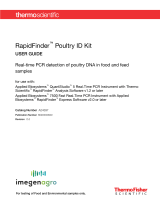 Thermo Fisher Scientific RapidFinder Poultry ID Kit Mode d'emploi
Thermo Fisher Scientific RapidFinder Poultry ID Kit Mode d'emploi
-
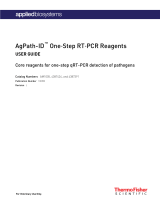 Thermo Fisher Scientific AgPath-ID One Step RT PCR Reagents Mode d'emploi
Thermo Fisher Scientific AgPath-ID One Step RT PCR Reagents Mode d'emploi
-
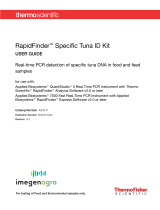 Thermo Fisher Scientific RapidFinder Specific Tuna ID Kit Mode d'emploi
Thermo Fisher Scientific RapidFinder Specific Tuna ID Kit Mode d'emploi
-
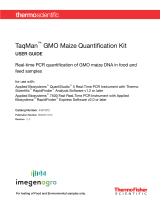 Thermo Fisher Scientific TaqMan GMO Maize Quantification Kit Mode d'emploi
Thermo Fisher Scientific TaqMan GMO Maize Quantification Kit Mode d'emploi
-
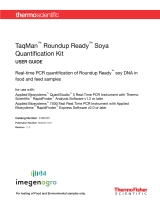 Thermo Fisher Scientific TaqMan Roundup Ready Soya Quantification Kit Mode d'emploi
Thermo Fisher Scientific TaqMan Roundup Ready Soya Quantification Kit Mode d'emploi
-
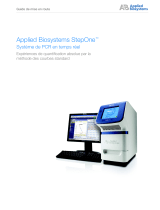 Thermo Fisher Scientific Applied Biosystems StepOne™ Système Le manuel du propriétaire
Thermo Fisher Scientific Applied Biosystems StepOne™ Système Le manuel du propriétaire
-
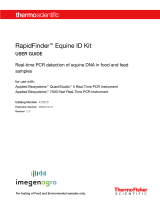 Thermo Fisher Scientific RapidFinder Equine ID Kit Mode d'emploi
Thermo Fisher Scientific RapidFinder Equine ID Kit Mode d'emploi
-
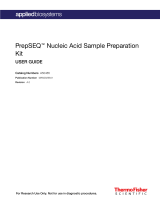 Thermo Fisher Scientific PrepSEQ Nucleic Acid Sample Preparation Kit Mode d'emploi
Thermo Fisher Scientific PrepSEQ Nucleic Acid Sample Preparation Kit Mode d'emploi
-
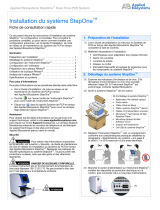 Thermo Fisher Scientific système StepOne™ Le manuel du propriétaire
Thermo Fisher Scientific système StepOne™ Le manuel du propriétaire
-
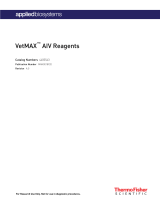 Thermo Fisher Scientific VetMAX AIV Reagents Mode d'emploi
Thermo Fisher Scientific VetMAX AIV Reagents Mode d'emploi
Autres documents
-
Bosch STI Test Manuel utilisateur
-
Gima 24618 Le manuel du propriétaire
-
Gima 24623 Le manuel du propriétaire
-
PRAXISDIENST 491005 Manuel utilisateur
-
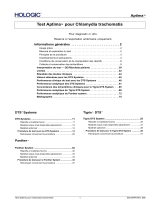 Hologic Aptima CT Assay, Panther; Aptima CT Assay, Tigris; Aptima CT Assay, DTS Mode d'emploi
Hologic Aptima CT Assay, Panther; Aptima CT Assay, Tigris; Aptima CT Assay, DTS Mode d'emploi
-
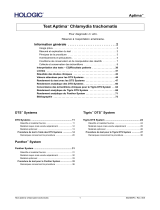 Hologic Aptima CT Assay, Panther; Aptima CT Assay, Tigris; Aptima CT Assay, DTS Mode d'emploi
Hologic Aptima CT Assay, Panther; Aptima CT Assay, Tigris; Aptima CT Assay, DTS Mode d'emploi

































